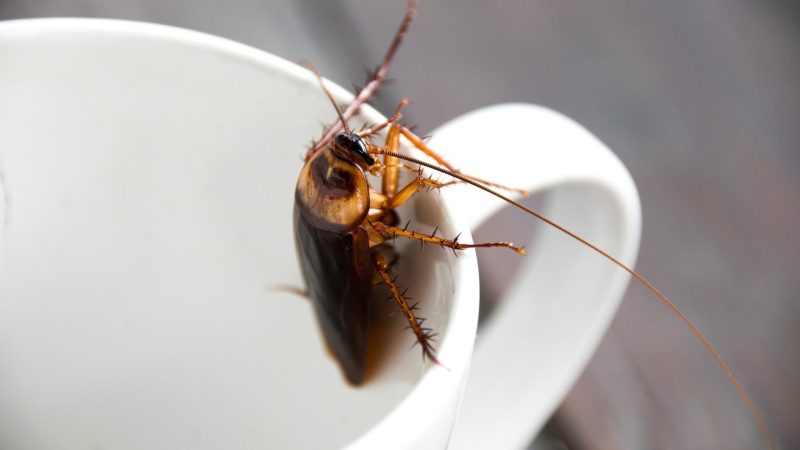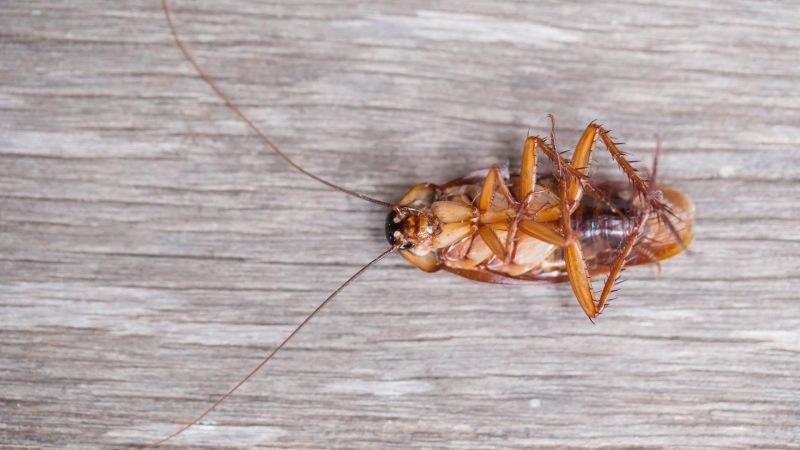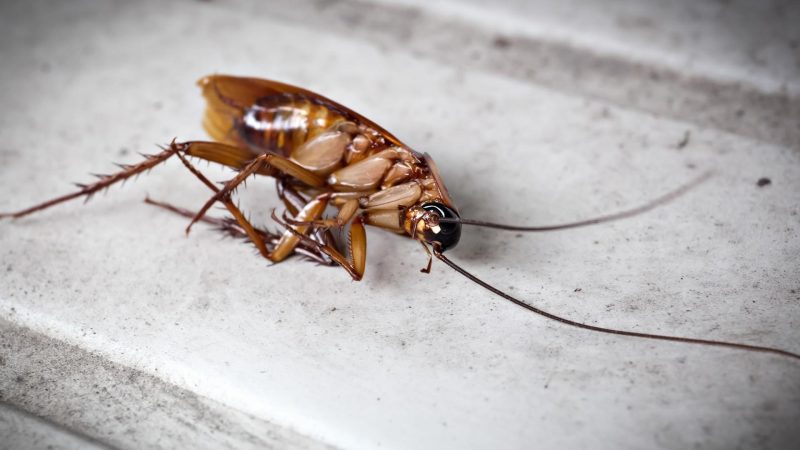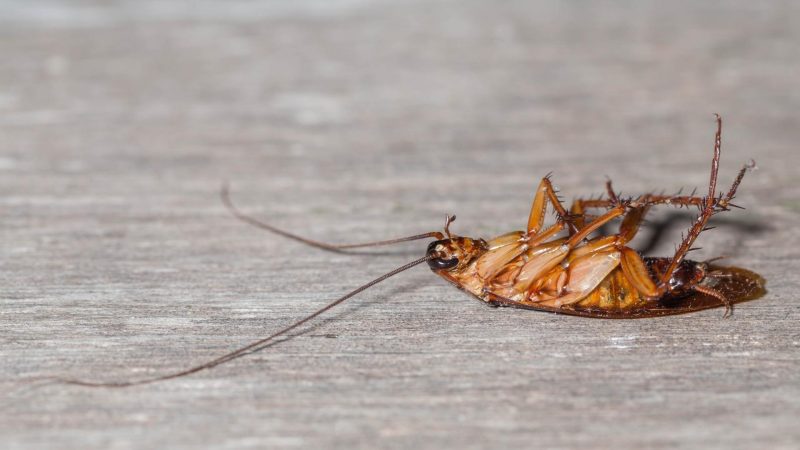As we live in our homes, we might have unwanted guests. Cockroaches are one of the most prevalent unwelcome guests. They show up in our homes because their eating habits are so similar to ours.
Do cockroaches play dead? Cockroaches play dead as their defense mechanism. If they see a predator or a human, they can pretend to be dead until the threat has passed. The cockroach will just remain motionless. However, when they determine that the threat has gone, they will simply continue where they left off.
Even if you find out the cockroach is not dead, there are ways to get rid of the infestation and keep them from returning to your house. Here is a helpful guide through cockroach self-defense mechanisms and ways to win this fight.
Where Can You Find Cockroaches?

Cockroaches are nocturnal insects. It means during the day, they hide in dark, tight, warm places like basements, behind the kitchen counters, under the fridge, beds, and closets. After the dark, they come out to search for food.
They are very unlikely to appear in the daylight. But if they appear in the daylight, it might indicate that the house is infested with cockroaches. If that happens, you want to repress them from the house because they can spread many different diseases like allergies, asthma, dysentery, food poisoning, diarrhea, leprosy, and plague.
Related: Where Do Cockroaches Live? | Preferred Habitats and Prevention Techniques
Why Do Cockroaches Play Dead?

There are several terms for when the cockroach plays dead, like playing possum, apparent death, or tonic immobility. The key reason for this to happen is the muscular spasm, in which case the insect is not capable of moving extremities.
This is a consequence of evolution. It is a self-defense mechanism insects use to avoid deadly situations and predators. However, in some cases, this behavior can be involuntary. It happens when there is the influence of cold temperatures, physical damage, or insecticide effect.
Cold Temperatures
Cockroaches, like all insects, are cold-blooded animals. That means they can move only if the environment is warm enough. For cockroaches, the optimum temperature for a normal life is 25-30°C. At 15°C, they are noticeably slower. On the other hand, at 4°C, they are paralyzed, which means they cannot move, eat or drink.
Physical Damage
Even if most people think it is enough to step on a cockroach or to bump it with some tool (like a shoe, pot, newspaper, etc.), sometimes the cockroach can survive. If you see that cockroach limbs are ripped off, and the cockroach is not moving, it is still not a sign of a dead cockroach.
Cockroaches can survive without their limbs, but they can’t move. However, when they grow their limbs back, it allows them to escape if you do not adequately get rid of them.
Moreover, there is a phenomenon of “headless cockroaches,” which they can live up to one month without their head. If this occurs, cockroaches are usually motionless, giving the impression that they are dead, yet they may flee and escape if necessary. They can’t eat, drink, or physically injure humans in this state, but they may still spread diseases.
Insecticide Effect
There are two types of insecticides used against cockroaches:
- Insecticides are meant to paralyze.
- Insecticides are meant to kill.
The first group is not meant to kill the insects. They can just paralyze them so they can’t move. For that matter, it can be mistaken for death. The second group of insecticides can kill cockroaches. Even if we use them, death will not be instantaneous due to the cockroaches’ strong exoskeleton.
If a cockroach inhales insecticide while spraying, it will die faster. But if not, the insect will be paralyzed for some time before it dies. However, if they have resistance to a particular insecticide, or it was not used properly, cockroaches can be paralyzed for some time and then just move on with their life.
How to Know if Cockroaches Play Dead?

If you see a cockroach that seems to be dead, be sure to have something near you to smash the insect or capture it. Then, you can check if the cockroach is dead by gently touching it with a feather or pencil. You can also put on gloves and touch them with your finger but never with your bare hands, because of diseases can spread. When stimulated, the cockroach will move their limbs.
The method above can work if paralysis comes from fear of death or if the cockroach loses their head or other parts of the body. However, if paralysis comes from the low temperature or insecticide effect, this method does not work every time. That is because in these cases, the insect does not control muscle spasms and can’t move even if they want to.
In case of a low temperature, if those conditions last too long, the cockroach will eventually die most likely from hunger. But if the temperature gets higher, cockroaches will thaw and get the opportunity to move again. A similar thing happens with insecticides. The length and severity of the cockroach’s paralysis are determined by the purpose and strength of the active chemical in the insecticide we use, as well as the cockroach’s resistance to it.
Do Cockroaches Always Die on Their Back?

We often see them on their back when they are dead, but it does not have to be that way. This phenomenon happens because of muscular spasms, especially when it is involuntary. When spasms happen because of cold temperatures, and more often because of the insecticide effect, cockroaches can’t control those spasms.
With that in mind and the fact that they bear the majority of their weight on their backs due to their high gravity point, strong involuntary spasms can throw them on their back. On the other hand, if they die for other reasons, which do not include muscular spasms, cockroaches will not turn on their backs if they are dying.
Related: Do Cockroaches Fart? | Unsettling Insights!
What to Do if There Is a Dead Cockroach in Your Home?
First, check if that particular cockroach gives any signs of life, and be prepared to smash it or trap it if it starts to move.
If you see a cockroach in your home (live or dead) there is a possibility of infestation. Consider the following procedures to get rid of them:
Step 1: Inspect your house and see if there are nests and possible entrances for other pests. Always inspect the whole house, behind and under every piece of furniture, and pay special attention to the kitchen. Do not forget to inspect doors, windows, and ventilation pipes.
Step 2: When you find the nest, be sure to not scare them away because they will find new places to hide, and it will get much harder to get rid of.
Step 3: Use any of traps , baits , spray insecticides .
- Quick Kill Formula – Your secret weapon against roaches Starts...
- Eliminates the nest – Roaches take the bait back to the nest,...
- Protects your home – Child resistant bait stations provide...
- Ready to Use – Easy to use with nothing to activate. No mess,...
- Use throughout your home – place bait stations wherever roaches...
- Quick Kill Formula – Your secret weapon against roaches Starts...
- Eliminates the nest – Roaches take the bait back to the nest,...
- Protects your home – Child resistant bait stations provide...
- Ready to Use – Easy to use with nothing to activate. No mess,...
- Use throughout your home – place bait stations wherever roaches...
- Bug spray that quickly kills ants, roaches and flies
- Plant-based active ingredient bug killer safe for use around...
- Entomologist tested bug spray made with botanical extracts to...
- Bug killer for indoor and outdoor use, wherever bugs try to...
- Rooted in Nature, Optimized by Science?
But if the infestation is bigger, it is best to call a pest control professional and let them deal with these pests since they are resistant to many insecticides and very hard to repress.
Related: Do Cockroaches Sleep? | Surprising Facts and Explanations
How to Stop Cockroaches From Entering Your House?
There are a few ways you can do to stop cockroaches from entering your house or, if they are already there, prevent them from spreading further. Some of these ways are the following:
- Always keep your home clean, especially the kitchen and bathroom.
- Never leave food on the counters.
- Clean the counters and the fridge regularly.
- Do not leave food for your pets.
- Make sure that water drains do not leak.
- Do not leave your garbage for too long.
- Vacuuming should be done regularly. When you’re finished vacuuming, make sure to clean your vacuum cleaner bag.
- Check your grocery bags and groceries before you store them.
Related: 8 Proven Home Remedies for Cockroaches | Effective and Natural Solutions
Summary
Cockroaches are very common pests in homes, especially in warmer climates. Over the years, they developed strong self-defense mechanisms to fight against predators and deadly situations. One of those mechanisms is to play dead when they sense danger. This is possible because of muscular spasms, where the temperature is too low, or there is an insecticide effect.
To check if they are dead, you can gently touch the cockroach but not with your bare hand. If it only plays dead, it will move. Moreover, if you see a dead cockroach in your home, you should look for its nests. You can repress them by yourself, or you can call a pest professional.
List of Sources
Cockroaches. (2018). Victoria State Government.
Sutherland, A. M., Dong-Hwan, C., Rust, M. K. (2019). Cockroaches. University of California Agriculture & Natural Resources.
Koehler, P. G., Bayer, B. E., Branscome, D. (2017). Cockroaches and Their Management. University of Florida.
- Bed Bug Surge 2025: How to Detect, Prevent, and Safely Eliminate Infestations in Top U.S. Cities - June 18, 2025
- Asian Needle Ants Invade US Homes: 2025 Guide to Identification, Risks, and Effective Control - June 11, 2025
- New World Screwworm Alert: How US Livestock Owners Can Prevent Outbreaks and Protect Herds [Summer 2025 Update] - June 8, 2025


